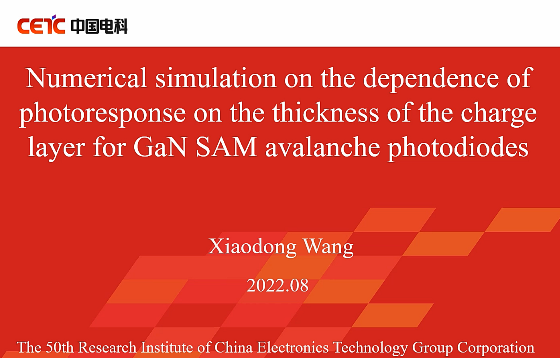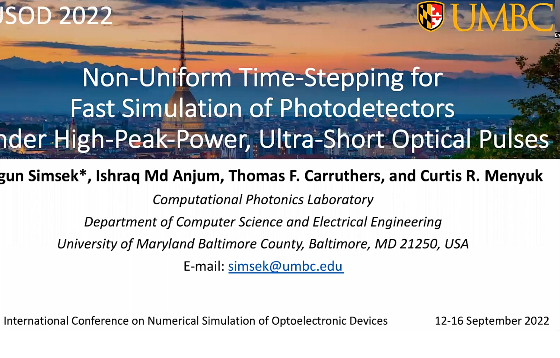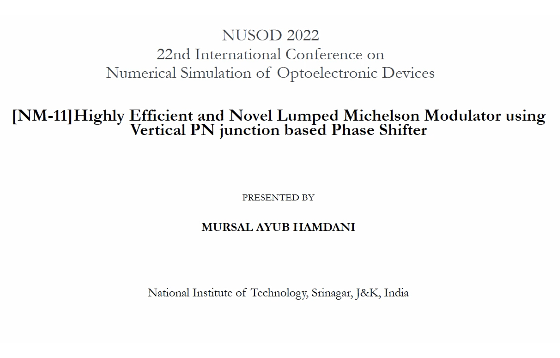


Dual D-shaped (DD-shaped) plasmonic photonic crystal fiber (PCF) for refractive index sensing is designed and analyzed. In the proposed design, two gold nano-rods are attached to the two etched surfaces of the PCF to enhance the sensing characteristics. The surface plasmon (SP) modes excited at the metal/dielectric interfaces are strongly coupled to the PCF core […]
LD10 – Effect of Self-Phase Modulation on The Signal Quality of Fourier Domain Mode-Locked Lasers
In this paper, the impact of self-phase modulation on the noise performance of Fourier Domain Mode-Locked (FDML) lasers is investigated. It is shown that under a relatively high fiber nonlinearity and/or intracavity signal amplitude, an excess amount of noise generation occurs, which can not only lead to poor signal quality, but also operational instability. Hence, […]
D08 – Numerical Simulation on the Effect of Operation Temperature on the Optical Transfer Characteristics for GaN/AlGaN SAM Avalanche Photodiodes
GaN/AlGaN avalanche photodiodes (APDs) have important application values and broad application potentials in the field of solar-blind ultraviolet (UV) detection. However, the self-heating effect has an obvious influence on the output characteristics of GaN/AlGaN APDs. In order to study the influence of self-heating temperature on its performance, the numerical model of GaN/AlGaN APDs is established […]
IS09 – Collision Dynamics of Solitons in a Grating Assisted Semilinear dual-core System with Phase Mismatch
The collision dynamics between two counterpropagating moving Bragg grating solitons and their outcomes in a model of semilinear dual-core Bragg-grating coupler with phase mismatch are investigated. The influence of gratings phase mismatch on the collision outcomes is also discussed.
D04 – Numerical simulation on the dependence of photoresponse on the thickness of the charge layer for GaN SAM avalanche photodiodes
GaN avalanche photodiode (APD) has important application prospects in the field of solar-blind ultraviolet (UV) detections. The back-illuminated GaN-based detector has been widely studied due to the advantages such as easy integration with readout circuit. Numerical model of GaN APD is established. The influence of the key function layer (charge layer) thickness on the device […]
LD04 – Modeling carrier transport in mid-infrared VCSELs with type-II superlattices and tunnel junctions
Vertical-cavity surface-emitting lasers are promising light sources for sensing and spectroscopy applications in the midinfrared 3 ÷4 µm spectral region. A type-II superlattice active region is used for carrier injection and confinement, while a buried tunnel junction defines a current aperture, decreasing the series resistivity. Highly nanostructured to optimize device performance, mid-infrared VCSELs pose modeling […]
LED08 – Influence of Prestrained Graded InGaN interlayer on the Optical Characteristics of InGaN/GaN MQW-based LEDs
In this work, an InGaN/GaN multi-quantum well light emitting diode is designed with different kinds of prestrain layers (InGaN) inserted between the active region and n-GaN layer to demonstrate the effects of piezoelectric polarization on GaN-based LEDs. The device describes a GaN buffer layer which promotes charge injection by minimizing energy barrier between electrode and […]
P08 – Tunable Guided-mode resonance filter using Spacetime Periodic Structure
We present a tunable planar guided-mode resonance (GMR) filter using time-varying permittivity along grating nanobars. Results show that the effective medium concept in the temporal state is exactly the same as the spatial state. Furthermore, the structure has spatial periodicity to save the resonance peak of the passive GMR in addition to the temporal periodicity […]
P20 – Simulation of Optical Planar Waveguide Sensor for Microplastics Detection in Water
Nowadays, microplastics pollution has become a global concern as it endangers the ecology, marine animals, and cause health threats to human beings. This paper attempted to simulate an optical planar waveguide sensor for microplastics detection in water via Wave Optics Module-COMSOL Multiphysics®. The analyte refractive index was ranged from 1.4800 to 1.5000 RIU, in reference […]
D09 – Analysis of Differential Phase Shift Quantum Key Distribution using single-photon detectors
We investigated the performance of differential phase shift quantum key distribution using InGaAs/InP and Silicon-APD (avalanche photo diode) for generating secure keys, secure communication distance, and bit error rates under the various operating conditions.We compare the quantum bit error rate and the secure key generation rate as a function of communication length.Our simulation results show […]
P15 – Numerical simulation of silicon grating-based plasmonic sensor
This work reports on the application of silicon grating-enabled nanostructure for refractive index sensing application in the near-infrared region. This grating helps in launching the plasmon modes efficiently towards the flat metal film deposited with a thin Al2O3 layer. The normal incidence light is used which can be helpful for its integration with optical fiber. […]
LD13 – Numerical Analysis of Electrically Pumped SiGeSn/GeSn Quantum Well Transistor Laser
The threshold current density of electrically pumped Sn incorporated group IV alloy based transistor laser (TL) is analyzed by proposing and designing a theoretical model for the same. Active region for the lasing action is formed by strain compensated GeSn single quantum well (QW) in the base of the transistor. The threshold current density for […]
P09 – 120° Hybrid for Bimodal Interferometers
An 120° hybrid for bimodal interferometers in the 220 nm silicon-on-insulator technology is presented. Three output signals enable an unambiguous phase detection over a 360°-range as well as a constant sensitivity. The length of the hybrid is only 190 µm with a simulated excess loss of 0.16 dB. Measurements combined with digital signal processing verify […]
P12 – Design and Simulation of Temperature Sensors Based on Thermo-Optical WGM Shifts in Silica and Non-Silica Glass Microcavities
Sensing applications of dielectric microcavities with whispering-gallery modes (WGMs) have been actively studied in the recent years. Here we investigated theoretically temperature microsensors based on different glasses, including common silica glass, as well as special germanate, tungsten-tellurite, arsenic sulfide and arsenic selenide glasses. We developed numerical model describing sensing characteristics of the considered microcavities. We […]
N05 – Effect of Poole-Frenkel emission on electroluminescence in quantum dot light emitting devices with Nickel Oxide layer
Theoretical analysis of hybrid quantum dot-light emitting devices incorporating CdSe/ZnS core/shell quantum dots and Nickel Oxide (NiO) as hole injection layer (HIL) has been carried out in this work. The replacement of organic HIL such as poly(3,4-ethylenedioxythiophene):poly(styrenesulfonate) (PEDOT:PSS) with solution-processed NiO layer has led to enhancement of current density and luminance in the device by […]
IS10 – Modelling and Characterisation of Silicon Waveguides in Photonic Integrated Circuits
Modelling and characterization of basic waveguiding structures in integrated photonics is important due to the large variety of established and emerging technologies used for fabrication. In this contribution we present a modelling and characterization approach for integrated silicon waveguides. We provide waveguide characteristics calculated from eigenmode simulation and optical measurement results.
NM04 – Semi-Analytic Modelling of Slot Waveguides in Silicon-Organic Hybrid Mach-Zehnder Modulators
A semi-analytic approach for modelling the distributed capacitance and the elecro-optic confinement factor of the slot waveguide in a silicon-organic hybrid Mach-Zehnder modulator using the principle of conformal mapping is presented. The results show a deviation of less than 1.3% compared with numerical field simulations.
D01 – Non-Uniform Time-Stepping For Fast Simulation of Photodetectors Under High-Peak-Power, Ultra-Short Optical Pulses
A novel non-uniform time-stepping procedure is developed to reduce the memory usage and simulation time—by two orders of magnitude—of photodetectors when detecting high-peak-power, ultra-short optical pulses. The proposed procedure can be used in other marching-on-in-time solvers to achieve the same for the simulations dealing with ultra-short pulses.
P06 – Flexible, Process-Aware Compact Model of Effective Index in Silicon Waveguides for Commercial Foundries
We report the performance of a compact model for the effective index of SOI wire waveguides, showing exceptional agreement with simulated effective index and confinement factors. The development of such a model represents a potential pathway toward better modeling of silicon photonic devices in commercial foundry processes.
MM02 – Carrier transport in (In,Ga)N quantum well systems: Connecting atomistic tight-binding electronic structure theory to drift-diffusion simulations
Understanding the impact of the alloy microstructure on carrier transport in (In,Ga)N/GaN quantum well systems is important for aiding device design. We study the impact that alloy fluctuations have on uni-polar carrier transport for both electrons (n-i-n junction) and holes (p-i-p junction) using a multiscale framework. To do so we connect an atomistic tight-binding model […]
LD08 – Modeling of THz Comb Emission in Difference-Frequency Quantum Cascade Lasers
The generation of terahertz (THz) frequency comb emission by intracavity difference frequency generation (DFG) in a mid-infrared (mid-IR) quantum cascade laser (QCL) is a promising alternative to direct THz QCL frequency comb generation. Concerning their room temperature operation capabilities, these devices are well suited for applications in rotational molecular spectroscopy and sensing. In order to […]
LD15 – Design Analysis of Linear Graded Quantum barriers in Ultravoilet-C Laser Diodes
We demonstrated ultraviolet laser diode with improved optical and electrical features. By employing linear graded rising aluminium concentration in phases from first quantum barrier to last quantum barrier, the suggested LD design improves internal quantum efficiency (IQE) and output power while minimizing the lasing threshold. The proposed LD increases optical gain while lowering carrier leakage […]
SC04 – Performance Evaluation of Lead-Free Cs2CuSbCl6 Perovskite Solar Cells for > 21.67% Efficiency
This work investigates the performance of Cs2CuSbCl6-based lead-free perovskite solar cells for photovoltaic applications. Cs2CuSbCl6 has a bandgap of 1.7eV and it is a durable and non-toxic material. Cs2CuSbCl6 can absorb more photons and thus obtain high efficiency. This work has been performed using SCAPS-1D software with the focus on optimizing the absorber layer thickness […]
D05 – Mode-Guided Infrared Absorption in Ge/SiO2 Grating for Large-Angle and Broadband Photodetection
The numerical simulation of the electromagnetic properties of the Ge/SiO2 grating structure with bottom distributed Bragg reflector. With mode guiding in Ge, the structure exhibits an absorption angle of 100° and broadband behavior from 1300 to 1500 nm.
IS01 – Network Authentication with Synchronized Chaotic Lasers
We numerically study a hardware method for network authentication, where a pair of matched (twins) chaotic lasers generate the same chaos when they synchronize, being subject to the same optical injection from a third chaotic laser. One of the lasers is in the secure environment, the other in the unsecure environment, and authorization is granted […]
LED03 – RGB LED active region design and optimization with Genetic Evolution Algorithm
Multi-quantum-well (MQW) LED is a complex distributed system with strong interaction between two opposite carrier flows, electrons and holes. For both types of carriers, the carrier injection into each QW depends on transport conditions across the whole active region (AR) and is affected by capture-recombination balance in all active QWs. Multi-color LEDs with different types […]
MM07 – Volume exclusion effects in perovskite charge transport modeling
Due to its flexibility, perovskite materials are a promising candidate for many semiconductor devices. For example, Perovskite Solar Cells (PSCs) have become recently one of the fastest growing photovoltaic technologies. In this work, we take volume exclusion effects into account by formulating two different current densities – either treating the mobility or the diffusion as […]
NM09 – Calculation of intersubband absorption in n-doped BaSnO3 quantum wells
In this work we explore novel and promising BaO/BaSnO3 perovskite-oxide quantum well material system which has recently attracted attention due to its many advantages and possible applications in electronic devices. We focus on calculation of intersubband absorption in La-doped BaSnO3 quantum wells and investigate the tuning of absorption spectra with QW thickness and external electric […]
NM11 – Highly Efficient and Novel Lumped Michelson Modulator using Vertical PN junction based Phase Shifter
Vertical PN depletion phase shifter based novel Common Mirror Michelson Modulator is proposed. It has a lower V, higher ER for a particular value of source impedance at a given bitrate and doping than conventional PN phase shifter based modulator.
IS13 – Design and Performance Analysis of All Optical Half Adder based on Carrier Reservoir SOA -Mach Zehnder Interferometer (MZI) Configuration
In this manuscript, Carrier reservoir SOA (CR-SOA) based half adder is proposed and simulated at 100 Gb/s. CR-SOA has fast carrier recovery, due to presence carrier reservoir which enables its use at higher data rates on the other hand conventional SOA suffers from slow carrier recovery which leads to unequal amplification of pulses. The obtained […]
































